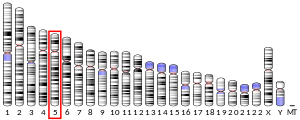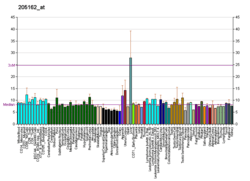ERCC8 (gene)
DNA excision repair protein ERCC-8 is a protein that in humans is encoded by the ERCC8 gene.[5][6]
This gene encodes a WD repeat protein, which interacts with the Cockayne syndrome type B (CSB) and p44 proteins, the latter being a subunit of the RNA polymerase II transcription factor II H. Mutations in this gene have been identified in patients with the hereditary disease Cockayne syndrome (CS). CS is an accelerated aging disorder characterized by photosensitivity, impaired development and multi-system progressive degeneration. The CS cells are abnormally sensitive to ultraviolet radiation and are defective in the repair of transcriptionally active genes. Multiple alternatively spliced transcript variants encoding different isoforms have been found for this gene.[6]
CS arises from germline mutations in either of two genes CSA(ERCC8) or CSB(ERCC6). CSA mutations generally give rise to a more moderate form of CS than CSB mutations.[7] Mutations in the CSA gene account for about 20% of CS cases.[8]
Function
CSA and CSB proteins are thought to function in transcription and DNA repair, most notably in transcription-coupled nucleotide excision repair. CSA and CSB-deficient cells exhibit a lack of preferential repair of UV-induced cyclobutane pyrimidine dimers in actively transcribed genes, consistent with a failed transcription coupled nucleotide excision repair response.[9] Within the cell, the CSA protein localizes to sites of DNA damage, particularly inter-strand cross-links, double-strand breaks and some mono-adducts.[7]
Interactions
ERCC8 (gene) has been shown to interact with XAB2.[10]
References
- GRCh38: Ensembl release 89: ENSG00000049167 - Ensembl, May 2017
- GRCm38: Ensembl release 89: ENSMUSG00000021694 - Ensembl, May 2017
- "Human PubMed Reference:". National Center for Biotechnology Information, U.S. National Library of Medicine.
- "Mouse PubMed Reference:". National Center for Biotechnology Information, U.S. National Library of Medicine.
- Itoh T, Shiomi T, Shiomi N, Harada Y, Wakasugi M, Matsunaga T, Nikaido O, Friedberg EC, Yamaizumi M (April 1996). "Rodent complementation group 8 (ERCC8) corresponds to Cockayne syndrome complementation group A". Mutat Res. 362 (2): 167–74. doi:10.1016/0921-8777(95)00046-1. PMID 8596535.
- "Entrez Gene: ERCC8 excision repair cross-complementing rodent repair deficiency, complementation group 8".
- Iyama T, Wilson DM (2016). "Elements That Regulate the DNA Damage Response of Proteins Defective in Cockayne Syndrome". J. Mol. Biol. 428 (1): 62–78. doi:10.1016/j.jmb.2015.11.020. PMC 4738086. PMID 26616585.
- Koch S, Garcia Gonzalez O, Assfalg R, Schelling A, Schäfer P, Scharffetter-Kochanek K, Iben S (2014). "Cockayne syndrome protein A is a transcription factor of RNA polymerase I and stimulates ribosomal biogenesis and growth". Cell Cycle. 13 (13): 2029–37. doi:10.4161/cc.29018. PMC 4111694. PMID 24781187.
- van Hoffen A, Natarajan AT, Mayne LV, van Zeeland AA, Mullenders LH, Venema J (1993). "Deficient repair of the transcribed strand of active genes in Cockayne's syndrome cells". Nucleic Acids Res. 21 (25): 5890–5. doi:10.1093/nar/21.25.5890. PMC 310470. PMID 8290349.
- Nakatsu Y, Asahina H, Citterio E, Rademakers S, Vermeulen W, Kamiuchi S, Yeo JP, Khaw MC, Saijo M, Kodo N, Matsuda T, Hoeijmakers JH, Tanaka K (November 2000). "XAB2, a novel tetratricopeptide repeat protein involved in transcription-coupled DNA repair and transcription". J. Biol. Chem. UNITED STATES. 275 (45): 34931–7. doi:10.1074/jbc.M004936200. ISSN 0021-9258. PMID 10944529.
Further reading
- van Gool AJ, van der Horst GT, Citterio E, Hoeijmakers JH (1997). "Cockayne syndrome: defective repair of transcription?". EMBO J. 16 (14): 4155–62. doi:10.1093/emboj/16.14.4155. PMC 1170041. PMID 9250659.
- Henning KA, Li L, Iyer N, et al. (1995). "The Cockayne syndrome group A gene encodes a WD repeat protein that interacts with CSB protein and a subunit of RNA polymerase II TFIIH". Cell. 82 (4): 555–64. doi:10.1016/0092-8674(95)90028-4. PMID 7664335.
- Bregman DB, et al. (1996). "UV-induced ubiquitination of RNA polymerase II: a novel modification deficient in Cockayne syndrome cells". Proc. Natl. Acad. Sci. U.S.A. 93 (21): 11586–90. Bibcode:1996PNAS...9311586B. doi:10.1073/pnas.93.21.11586. PMC 38101. PMID 8876179.
- Selby CP, Sancar A (1997). "Human transcription-repair coupling factor CSB/ERCC6 is a DNA-stimulated ATPase but is not a helicase and does not disrupt the ternary transcription complex of stalled RNA polymerase II". J. Biol. Chem. 272 (3): 1885–90. doi:10.1074/jbc.272.3.1885. PMID 8999876.
- Nakatsu Y, Asahina H, Citterio E, et al. (2001). "XAB2, a novel tetratricopeptide repeat protein involved in transcription-coupled DNA repair and transcription". J. Biol. Chem. 275 (45): 34931–7. doi:10.1074/jbc.M004936200. PMID 10944529.
- Kamiuchi S, et al. (2002). "Translocation of Cockayne syndrome group A protein to the nuclear matrix: possible relevance to transcription-coupled DNA repair" (PDF). Proc. Natl. Acad. Sci. U.S.A. 99 (1): 201–6. Bibcode:2002PNAS...99..201K. doi:10.1073/pnas.012473199. PMC 117539. PMID 11782547.
- Strausberg RL, et al. (2003). "Generation and initial analysis of more than 15,000 full-length human and mouse cDNA sequences". Proc. Natl. Acad. Sci. U.S.A. 99 (26): 16899–903. Bibcode:2002PNAS...9916899M. doi:10.1073/pnas.242603899. PMC 139241. PMID 12477932.
- Groisman R, Polanowska J, Kuraoka I, et al. (2003). "The ubiquitin ligase activity in the DDB2 and CSA complexes is differentially regulated by the COP9 signalosome in response to DNA damage". Cell. 113 (3): 357–67. doi:10.1016/S0092-8674(03)00316-7. PMID 12732143.
- Cao H, Williams C, Carter M, Hegele RA (2004). "CKN1 (MIM 216400): mutations in Cockayne syndrome type A and a new common polymorphism". J. Hum. Genet. 49 (1): 61–3. doi:10.1007/s10038-003-0107-2. PMID 14661080.
- Ota T, Suzuki Y, Nishikawa T, et al. (2004). "Complete sequencing and characterization of 21,243 full-length human cDNAs". Nat. Genet. 36 (1): 40–5. doi:10.1038/ng1285. PMID 14702039.
- Gerhard DS, Wagner L, Feingold EA, et al. (2004). "The status, quality, and expansion of the NIH full-length cDNA project: the Mammalian Gene Collection (MGC)". Genome Res. 14 (10B): 2121–7. doi:10.1101/gr.2596504. PMC 528928. PMID 15489334.
- Ridley AJ, Colley J, Wynford-Thomas D, Jones CJ (2005). "Characterisation of novel mutations in Cockayne syndrome type A and xeroderma pigmentosum group C subjects". J. Hum. Genet. 50 (3): 151–4. doi:10.1007/s10038-004-0228-2. PMID 15744458.
- Sarker AH, Tsutakawa SE, Kostek S, et al. (2006). "Recognition of RNA polymerase II and transcription bubbles by XPG, CSB, and TFIIH: insights for transcription-coupled repair and Cockayne Syndrome". Mol. Cell. 20 (2): 187–98. doi:10.1016/j.molcel.2005.09.022. PMID 16246722.
- Groisman R, Kuraoka I, Chevallier O, et al. (2006). "CSA-dependent degradation of CSB by the ubiquitin-proteasome pathway establishes a link between complementation factors of the Cockayne syndrome". Genes Dev. 20 (11): 1429–34. doi:10.1101/gad.378206. PMC 1475755. PMID 16751180.
- Fousteri M, Vermeulen W, van Zeeland AA, Mullenders LH (2006). "Cockayne syndrome A and B proteins differentially regulate recruitment of chromatin remodeling and repair factors to stalled RNA polymerase II in vivo". Mol. Cell. 23 (4): 471–82. doi:10.1016/j.molcel.2006.06.029. PMID 16916636.
- Saijo M, Hirai T, Ogawa A, et al. (2007). "Functional TFIIH is required for UV-induced translocation of CSA to the nuclear matrix". Mol. Cell. Biol. 27 (7): 2538–47. doi:10.1128/MCB.01288-06. PMC 1899911. PMID 17242193.
- D'Errico M, Parlanti E, Teson M, et al. (2007). "The role of CSA in the response to oxidative DNA damage in human cells". Oncogene. 26 (30): 4336–43. doi:10.1038/sj.onc.1210232. PMID 17297471.




